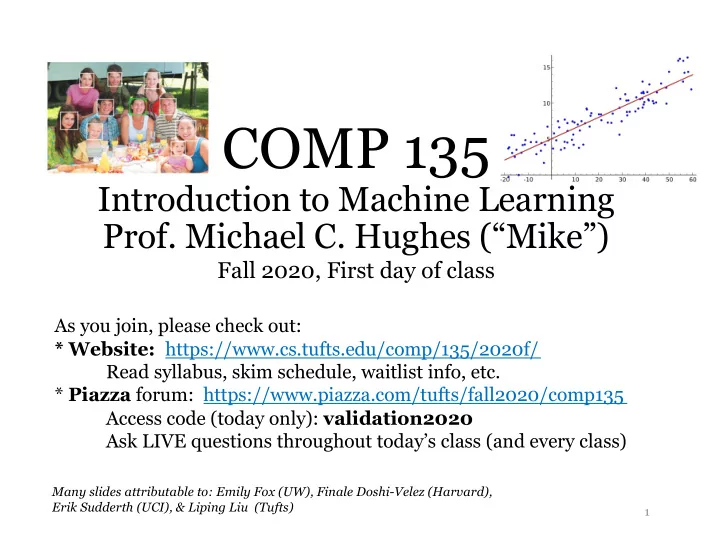

COMP 135 Introduction to Machine Learning Prof. Michael C. Hughes (“Mike”) Fall 2020, First day of class As you join, please check out: * Website: https://www.cs.tufts.edu/comp/135/2020f/ Read syllabus, skim schedule, waitlist info, etc. * Piazza forum: https://www.piazza.com/tufts/fall2020/comp135 Access code (today only): validation2020 Ask LIVE questions throughout today’s class (and every class) Many slides attributable to: Emily Fox (UW), Finale Doshi-Velez (Harvard), Erik Sudderth (UCI), & Liping Liu (Tufts) 1
Today’s Agenda • Why take this course? • What is Machine Learning? • What skills/concepts will we learn? • Who is teaching? • How will we spend our time? Mike Hughes - Tufts COMP 135 - Fall 2020 2
Q: Why should you take this course? A: Machine Learning is everywhere! Those who know how to wield it effectively and responsibly can change the world. Mike Hughes - Tufts COMP 135 - Spring 2019 3
Image Credit: Emily Fox Mike Hughes - Tufts COMP 135 - Fall 2020 4
Goals of this course Our goal is to prepare students to effectively apply machine learning methods to problems that might arise in "the real world" -- in industry, medicine, government, education, and beyond. Gain skills and understanding for a future as: • Developer using ML “out-of-the-box” • ML methods researcher Mike Hughes - Tufts COMP 135 – Fall 2020 5
After taking this course, you will be able to: - Think systematically and ethically - Compare/contrast each method’s strengths & limitations - "Can ML solve this problem?” - “ Should ML solve this problem?” - Deploy and debug rapidly on real problems - Hands-on experience with open-source libraries - Address issues in “real-world” data analysis - Numerical issues, convergence issues, class imbalance, missing values, etc. - Evaluate carefully and honestly - Design experiments to assess generalization to never-before-seen data - Select task-appropriate performance metrics - Report confidence or uncertainty in performance numbers - Communicate insightfully and reproducibly - Surface key insights via figures, tables, and text in a written report - Provide details for a peer to repeat your analysis and draw same conclusions Mike Hughes - Tufts COMP 135 - Fall 2020 6
Q: What is Machine Learning? Mike Hughes - Tufts COMP 135 - Fall 2020 7
Venn Diagram of Knowledge Artificial Intelligence (AI) Statistics Machine Learning (ML) Deep = Learning Data Science Mike Hughes - Tufts COMP 135 - Fall 2020 8
Artificial Intelligence (AI) Study of “intelligent” systems, with many parts: logic, planning, search, probabilistic reasoning, learning from experience, interacting with other agents, etc. Alpha Go DARPA Grand Challenge Computer that can beat best human players Autonomous vehicles can navigate a real-world of the game of “Go” (harder than chess) course without humans at the wheel Mike Hughes - Tufts COMP 135 - Fall 2020 9
Machine Learning (ML) Study of computer programs that learn from experience/data to perform a task • Output: a prediction, decision, or summary Face Detection Movie Recommendation Predict location of human faces in natural images Predict what to watch next Mike Hughes - Tufts COMP 135 - Fall 2020 10
The Machine Learning Process Performance Past data Task / Goal measure (or “experience”) input data prediction / decision (now) (now) Mike Hughes - Tufts COMP 135 - Fall 2020 11
Q: What concepts will we learn? Mike Hughes - Tufts COMP 135 - Fall 2020 12
What will we learn? Supervised Learning Data, Label Pairs Performance { x n , y n } N measure Task n =1 Unsupervised Learning data label x y Reinforcement Learning Mike Hughes - Tufts COMP 135 - Fall 2020 13
Task: Regression y is a continuous variable Supervised e.g. sales in $$ Learning regression y Unsupervised Learning Reinforcement x Learning Mike Hughes - Tufts COMP 135 - Fall 2020 14
Regression Example: Uber Supervised Learning regression Unsupervised Learning Reinforcement Learning Mike Hughes - Tufts COMP 135 - Fall 2020 15
Regression Example: Uber Mike Hughes - Tufts COMP 135 - Fall 2020 16
Regression Example: Uber Mike Hughes - Tufts COMP 135 - Fall 2020 17
Task: Classification y is a discrete variable Supervised (red or blue) Learning classification x 2 Unsupervised Learning Reinforcement Learning x 1 Mike Hughes - Tufts COMP 135 - Fall 2020 18
Classification Example: Swype Mike Hughes - Tufts COMP 135 - Fall 2020 19
What will we learn? Supervised Learning Data, Label Pairs Performance { x n , y n } N measure Task n =1 Unsupervised Learning data label x y Reinforcement Learning Mike Hughes - Tufts COMP 135 - Fall 2020 20
What will we learn? Supervised Learning Data Examples Performance { x n } N measure Task n =1 Unsupervised Learning summary data of x x Reinforcement Learning Mike Hughes - Tufts COMP 135 - Fall 2020 21
Task: Embedding Supervised Learning x 2 Unsupervised Learning embedding Reinforcement x 1 Learning Mike Hughes - Tufts COMP 135 - Fall 2020 22
Example: Genes vs. geography Mike Hughes - Tufts COMP 135 - Fall 2020 23
Task: Recommendation Supervised Learning recommendation Unsupervised Learning Reinforcement Learning Mike Hughes - Tufts COMP 135 - Fall 2020 24
Recommendation Example Mike Hughes - Tufts COMP 135 - Fall 2020 25
What will we learn? Histories of states, Supervised actions, rewards Learning Performance { s t , a t , r t , s t +1 , . . . } N n =1 measure Task Unsupervised Learning Recent Next history action a Reinforcement Learning Mike Hughes - Tufts COMP 135 - Fall 2020 26
RL example: Pancake robot Mike Hughes - Tufts COMP 135 – Fall 2020 27
What won’t we cover? • Clustering • Probabilistic models • Graphical models • Active learning • Transfer learning • Semi-supervised learning • Learning theory • ….. lots more Mike Hughes - Tufts COMP 135 - Fall 2020 28
Recommend
More recommend